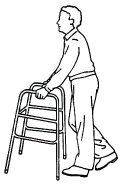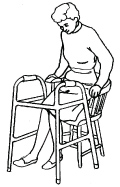Physiotherapy: How to use a 2-wheeled walker
Physiotherapy
How to use a 2-wheeled walker
This information has been translated into other languages – see the links at the bottom of this page.
Fitting a 2-wheeled walker

- Put on the shoes you’ll be wearing when you use the 2-wheeled walker.
- Stand up straight.
- Put the walker in front of and partly around you.
- Put both hands on the hand grips of the walker.
Your elbows should be slightly bent, and the hand grip should be at wrist level when your arm is hanging by your side. Adjust the height of the walker if the hand grips aren’t at wrist level.
Your weight bearing order is:
| Non weight-bearing | No bodyweight on your injured leg. Keep your injured leg off the floor at all times. |
| Feather weight-bearing | Able to touch your toe down to the floor for balance only. Don’t put any weight on the injured leg. Imagine having an egg under your foot that you don’t want to crush. |
| Partial weight-bearing | Able to put up to half of your weight through your injured leg. |
| Weight bearing as tolerated | Can take most or all your weight through your injured leg, as pain or strength allows. |
| Full weight-bearing | Able to take full weight through your injured leg. |
Use the method you were shown with the instructions below.
Walking

- Stand the 2-wheeled walker in front of and partly around you.
- Move the walker 1 step length ahead of you. Put all 4 legs of the walker on the floor.
- Move the injured leg forward, then push down on the walker using your arms.
- Move your stronger leg forward, even with or slightly ahead of your injured leg.
- Keep at least 15 to 20 cm (6 to 8 inches) between you and the front of the walker.
- Repeat these steps to keep walking—walker, injured leg, stronger leg.
Sitting and standing

- Stand with your back to the chair with the walker close to you.
- Put the back of your good leg against the chair.
- Slide your injured leg slightly forward.
- Put both hands on the armrests or seat of the chair.
- Lower yourself gently onto the chair.
- Move back in the chair if you need to.
- Reverse the procedure to stand.
Note: Don’t sit on unstable or very low chairs.
Curb step with a 2-wheeled walker
- Walk as close as you can to the curb step.
- When your balance is ready, lift the walker up onto the curb.
- Step up on to the curb putting your stronger leg up first.
- Bring up your injured leg.
- To step down, put the walker down to the next level. Put your injured leg forward or down first, then step down with your stronger leg.
Note: Never use your walker to go up or down more than 1 curb step.
Safety tips
- Always wear supportive shoes instead of slippers.
- Check that the rubber tips of the walker aren’t worn. Replace them if needed.
- Don’t put the walker too far ahead of you when walking. A good rule is to have the walker no more than 1 step length in front of you.
- Don’t step too far into the walker when walking. This may cause you to lose your balance backwards.
- Don’t lean or pull on the walker when getting up or sitting down. This could tip the walker over.
- Watch for wet surfaces. Use small steps if you must walk on a wet or slippery surface.
- Remove loose mats and rugs from the floors in your home. These could cause you to trip or slip.
- Don’t use your walker on stairs.
Your doctor or physiotherapist will tell you when you can stop using your walker.
To see this information online and learn more, visit MyHealth.Alberta.ca/health/pages/conditions.aspx?Hwid=custom.ab_physio_walker_inst.

Other languages
Physiotherapy: How to use a walker
For 24/7 nurse advice and general health information call Health Link at 811.
Current as of: November 14, 2023
Author: Allied Health (Physiotherapy), Alberta Health Services
This material is not a substitute for the advice of a qualified health professional. This material is intended for general information only and is provided on an "as is", "where is" basis. Although reasonable efforts were made to confirm the accuracy of the information, Alberta Health Services does not make any representation or warranty, express, implied or statutory, as to the accuracy, reliability, completeness, applicability or fitness for a particular purpose of such information. Alberta Health Services expressly disclaims all liability for the use of these materials, and for any claims, actions, demands or suits arising from such use.
